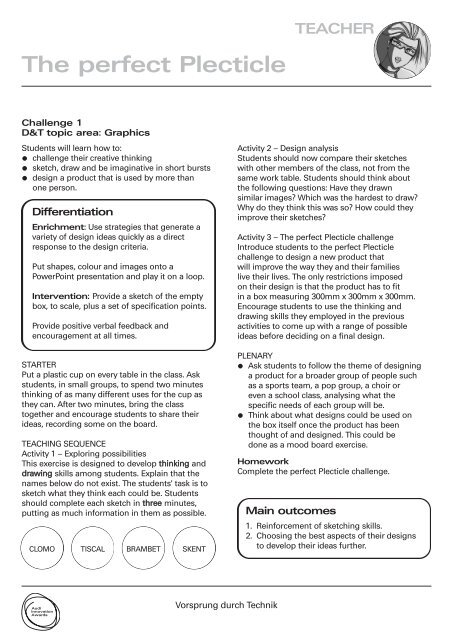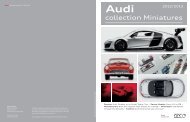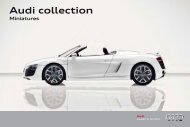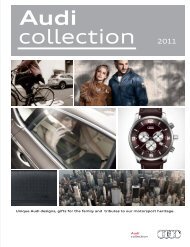The perfect Plecticle - Audi
The perfect Plecticle - Audi
The perfect Plecticle - Audi
You also want an ePaper? Increase the reach of your titles
YUMPU automatically turns print PDFs into web optimized ePapers that Google loves.
<strong>The</strong> <strong>perfect</strong> <strong>Plecticle</strong><br />
Challenge 1<br />
D&T topic area: Graphics<br />
Students will learn how to:<br />
challenge their creative thinking<br />
sketch, draw and be imaginative in short bursts<br />
design a product that is used by more than<br />
one person.<br />
Differentiation<br />
Enrichment: Use strategies that generate a<br />
variety of design ideas quickly as a direct<br />
response to the design criteria.<br />
Put shapes, colour and images onto a<br />
PowerPoint presentation and play it on a loop.<br />
Intervention: Provide a sketch of the empty<br />
box, to scale, plus a set of specification points.<br />
Provide positive verbal feedback and<br />
encouragement at all times.<br />
STARTER<br />
Put a plastic cup on every table in the class. Ask<br />
students, in small groups, to spend two minutes<br />
thinking of as many different uses for the cup as<br />
they can. After two minutes, bring the class<br />
together and encourage students to share their<br />
ideas, recording some on the board.<br />
TEACHING SEQUENCE<br />
Activity 1 – Exploring possibilities<br />
This exercise is designed to develop thinking and<br />
drawing skills among students. Explain that the<br />
names below do not exist. <strong>The</strong> students' task is to<br />
sketch what they think each could be. Students<br />
should complete each sketch in three minutes,<br />
putting as much information in them as possible.<br />
CLOMO TISCAL BRAMBET SKENT<br />
Vorsprung durch Technik<br />
TEACHER<br />
Activity 2 – Design analysis<br />
Students should now compare their sketches<br />
with other members of the class, not from the<br />
same work table. Students should think about<br />
the following questions: Have they drawn<br />
similar images? Which was the hardest to draw?<br />
Why do they think this was so? How could they<br />
improve their sketches?<br />
Activity 3 – <strong>The</strong> <strong>perfect</strong> <strong>Plecticle</strong> challenge<br />
Introduce students to the <strong>perfect</strong> <strong>Plecticle</strong><br />
challenge to design a new product that<br />
will improve the way they and their families<br />
live their lives. <strong>The</strong> only restrictions imposed<br />
on their design is that the product has to fit<br />
in a box measuring 300mm x 300mm x 300mm.<br />
Encourage students to use the thinking and<br />
drawing skills they employed in the previous<br />
activities to come up with a range of possible<br />
ideas before deciding on a final design.<br />
PLENARY<br />
Ask students to follow the theme of designing<br />
a product for a broader group of people such<br />
as a sports team, a pop group, a choir or<br />
even a school class, analysing what the<br />
specific needs of each group will be.<br />
Think about what designs could be used on<br />
the box itself once the product has been<br />
thought of and designed. This could be<br />
done as a mood board exercise.<br />
Homework<br />
Complete the <strong>perfect</strong> <strong>Plecticle</strong> challenge.<br />
Main outcomes<br />
1. Reinforcement of sketching skills.<br />
2. Choosing the best aspects of their designs<br />
to develop their ideas further.
Ambient sounds<br />
Challenge 2<br />
D&T topic area: Systems and control<br />
Students will learn how to:<br />
forward think by using Mind Maps to create a<br />
more advanced product<br />
respond to a specific design brief and sketch in<br />
short specified time periods<br />
analyse other technologies to assist in their<br />
own designing.<br />
Differentiation<br />
Enrichment: Make a selection of music<br />
players available for use as a stimulus for<br />
initial designs.<br />
Intervention: Encourage students to observe<br />
how others are tackling the activities.<br />
STARTER<br />
Provide students with a variety of examples<br />
(images or objects) of music players that have<br />
been used over the past 10 years. Take 10 minutes<br />
to think about how these music players have<br />
evolved and how designers have improved on<br />
the basic concept of playing music.<br />
TEACHING SEQUENCE<br />
Activity 1 – Quick design exercise<br />
Try to source the following items (from home or<br />
school): a record player, cassette player, mini disc<br />
player, CD walkman, mini radio, MP3 player. Display<br />
the six existing methods of playing music and ask<br />
students to discuss the following questions: How are<br />
each of the players powered? To whom would the<br />
players be most suited? Think about durability - what<br />
is going to last the longest and why? What elements<br />
have stayed the same throughout each design?<br />
When students have identified the most effective<br />
features of all the previous designs, ask them to<br />
Mind Map up to 10 ideas in 20 minutes of what the<br />
next step in listening to music might be.<br />
Vorsprung durch Technik<br />
TEACHER<br />
A Mind Map is simply a lot of words and pictures<br />
on a page. When asked to design something<br />
students tend to concentrate on one design and<br />
therefore seldom explore lots of possibilities. Further<br />
information on mind maps can be found on:<br />
http://en.wikipedia.org/wiki/Mind_map<br />
http://www.mycoted.com/creativity/techniques/mind<br />
map.php http://www.londongt.org/think-link/<br />
Activity 2 – Ambient sounds challenge<br />
Introduce students to the Ambient sounds<br />
challenge. <strong>The</strong> challenge does not require students<br />
to create a new product from scratch but explore a<br />
range of existing products. <strong>The</strong> emphasis needs to<br />
be on the way the music player will function and<br />
not the specific electrical circuits that represent<br />
how. Explore the variety of circuits, such as smell,<br />
sound, fingerprint or eye recognition. Students<br />
should respond to the challenge brief by designing<br />
their new music player on one side of A3 paper. You<br />
may want to encourage students to consider the<br />
following questions: How will it be activated,<br />
perhaps by voice, or reading thoughts? Could it be<br />
a computer that scans the eye and then plays<br />
music tracks? Could a small device be implanted in<br />
someone’s head to pick up transmissions from a<br />
central point? Would the device be handheld?<br />
PLENARY<br />
Think about how the new product could be used<br />
by more than one person. Could it be placed in a<br />
public space?<br />
Homework<br />
Complete the Ambient sounds challenge.<br />
Main outcomes<br />
1. Student realisation of product analysis.<br />
2. Reinforcement of sketching skills.<br />
3. Choosing the best aspects of existing<br />
designs to develop their own ideas.
Enviromenta<br />
Challenge 3<br />
D&T topic area: Product design<br />
Students will learn how to:<br />
write a specification<br />
consider social and moral aspects when designing<br />
realise that, as designers, we have a<br />
responsibility towards the environment.<br />
Differentiation<br />
Enrichment: Invite teachers from other<br />
departments to talk about current environmental<br />
issues and how they are being addressed.<br />
Intervention: Give students a copy of<br />
the challenge with the key specification<br />
points highlighted.<br />
STARTER<br />
Students should spend five minutes discussing<br />
reasons for the following problems and how<br />
people are trying to deal with them:<br />
diminishing natural resources<br />
solar radiation<br />
ozone depletion<br />
overcrowding<br />
TEACHING SEQUENCE<br />
Activity 1 – Design analysis<br />
Remaining in their groups, ask students to<br />
develop their initial thoughts on the following<br />
two problems: ozone depletion and diminishing<br />
fuel resources. Students should complete a<br />
research task to answer these questions:<br />
1. How are the world problems currently<br />
being addressed?<br />
2. Which of the problems is most pressing?<br />
3. What would students do to solve them?<br />
Activity 2 – Writing a specification<br />
Introduce students to the initial ideas of<br />
the challenge (see overleaf). Students should<br />
read through the challenge and highlight the key<br />
Vorsprung durch Technik<br />
TEACHER<br />
words and sentences. <strong>The</strong>se can then be put into<br />
a list to form the specification. Remind students<br />
that the specification is a list of what the product<br />
must do, be and have in order to be successful<br />
to the client or end-user.<br />
Activity 3 – Enviromenta challenge<br />
Introduce students to the challenge brief<br />
to design a device that will help to solve one<br />
of the two key world problems that have been<br />
identified. <strong>The</strong> specification they produced in<br />
Activity 2 should form the basis for their design<br />
development. Remind students they should<br />
refer back to it during the design process<br />
to ensure they are meeting the requirements<br />
they set.<br />
Evidence of environmental research is also<br />
important. Encourage students to think about<br />
how the device will take this knowledge of<br />
the environmental issues and affect the people<br />
causing the problems: kinetic energy, so it is<br />
activated by the movement of the super-heroine;<br />
thought-recognition processes that then directly<br />
affect others; wind power, caused by movement<br />
through the air.<br />
EXTENSION<br />
A supporting lesson plan is available on<br />
www.audiinnovation.org.<br />
Homework<br />
Complete the Enviromenta challenge.<br />
Main outcomes<br />
1. Students understand how to include effects<br />
on the environment when designing.<br />
2. Students write a design specification.
Technology Pod<br />
Challenge 4<br />
D&T topic area: Resistant materials<br />
Students will learn how to:<br />
challenge their creative thinking<br />
sketch, draw and be imaginative in short bursts<br />
look at existing ways of travelling to extreme<br />
locations to collect materials and data.<br />
Differentiation<br />
Enrichment: Have available some draft<br />
examples of the challenge to inspire the<br />
class but encourage students not to copy<br />
the overall design.<br />
Intervention: Provide positive verbal<br />
feedback and encouragement at all times.<br />
STARTER<br />
In three minutes, ask students to list as many<br />
different modes of transport as possible, including<br />
vehicles that travel by land, sea and air. Which of<br />
these could be used by up to six people? If<br />
students could combine two of these modes of<br />
transport, which would they choose and why?<br />
TEACHING SEQUENCE<br />
Activity 1 – Exploring possibilities<br />
This exercise is designed to help focus students<br />
on the task at hand. Encourage students to use<br />
the internet, books or magazines to help<br />
conduct their initial research.<br />
Investigate current ways of achieving a similar,<br />
fast journey to the one in the challenge.<br />
Investigate existing super-strong materials and<br />
how students could improve them.<br />
Look at existing ways of providing comfortable<br />
and practical travel. You could encourage<br />
students to investigate space vehicles as they<br />
are forms of multi-task vehicles, but remind<br />
them that they are thinking about how this<br />
could be applied on earth and not in space.<br />
Vorsprung durch Technik<br />
TEACHER<br />
Activity 2 – Quick design exercise<br />
Ask students, in pairs, to consider these three<br />
extremes. Extreme Heat, Extreme Cold and Extreme<br />
Depth. Spend two minutes sketching three vehicles<br />
that could cope with each of these themes. Remind<br />
students that the function of the vehicle is just as<br />
important as the aesthetics. Students should then<br />
combine the three drawings.<br />
Activity 3 – Technology Pod challenge<br />
Introduce students to the Technology Pod challenge<br />
(see overleaf). This activity will offer students the<br />
opportunity to look at existing, modern transport<br />
designs as a means of inspiration and then combine<br />
the most effective elements of these to create a new<br />
product. To aid them in their design, encourage<br />
students to particularly consider existing transport<br />
methods used by scientists, which may include<br />
lorries, vans, helicopters, planes, hovercraft and even<br />
their own legs! Remind students that their design<br />
should be realistic as this has the potential to be<br />
developed in the near future.<br />
PLENARY<br />
A team of three students could complete this<br />
challenge. <strong>The</strong>re are three drawings to complete and<br />
an A4 sheet of explanations to create. All three<br />
students could design the outside of the craft and<br />
then split to provide the other parts of the challenge.<br />
Homework<br />
Complete the Technology Pod challenge.<br />
Main outcomes<br />
1. Using exemplar ideas to assist with designing.<br />
2. Reinforcement of sketching skills.<br />
3. Develop detailed criteria for designs and use<br />
these to explore design proposals.
AthleTex<br />
Challenge 5<br />
D&T topic area: Textiles<br />
Differentiation<br />
Extension: Extend the Starter by asking<br />
students to produce a brainstorm of their<br />
selected Textile through independent<br />
internet research.<br />
Intervention: For the written work in<br />
Activity 1, use a simplified list of words.<br />
STARTER<br />
Split the class into groups of three or four and issue<br />
students with information about a form of Smart,<br />
Techno or Futuristic Textiles. A variety of information<br />
is available on www.audiinnovation.org. Each group<br />
can produce notes or diagrams, or just discuss the<br />
information gained. Bring the class back together.<br />
Ask individual volunteers to go under the 'spotlight'<br />
and share what they have learned with the rest of<br />
the group.<br />
TEACHING SEQUENCE<br />
Activity 1 – Emotional response<br />
Give each group of students a list of words that<br />
reflect different emotions on Post-it notes. Also<br />
provide pencils and a piece of designer's work<br />
(examples at www.audiinnovations.org). <strong>The</strong> piece<br />
should be quite 'funky' and original in order to<br />
inspire students.<br />
Ask students to look at the item and choose five<br />
words from the supplied list, or write down their<br />
own five words that reflect their feelings towards<br />
the image. Students should stick these words on<br />
the image and feed back to the whole group why<br />
they chose the words and how the product, and<br />
therefore the designer, affected them.<br />
Activity 2 – Design developments<br />
Give each student a piece of A4 paper and<br />
display the images from Activity 1 around the<br />
classroom for the whole group to access. <strong>The</strong>n<br />
Vorsprung durch Technik<br />
TEACHER<br />
ask students to design a unisex lightweight<br />
waterproof jacket. Each student has three minutes<br />
and should be encouraged to look at the work<br />
of the designers used in Activity 1. After three<br />
minutes each student passes their design to<br />
the student on their left, who then has two<br />
minutes to improve the idea making as many<br />
changes as required (annotation should be<br />
encouraged). This should continue until all the<br />
students in the group have made their own<br />
design decisions to each initial idea. Finally,<br />
discuss the changes made and how the designs<br />
have been improved.<br />
Activity 3 – <strong>The</strong> AthleTex challenge<br />
Introduce students to the AthleTex challenge<br />
(see overleaf). Show students some examples<br />
of spec drawings or fashion illustrations to<br />
improve communication techniques and ask them<br />
to work in pairs for 10 minutes to create a range of<br />
exciting possibilities in the form of flat drawings.<br />
PLENARY<br />
Ask students to feed back in pairs some of their<br />
positive responses to the challenge and how their<br />
ideas could be developed further.<br />
Homework<br />
Complete the AthleTex challenge.<br />
Main outcomes<br />
1. Understand the challenge set and how to<br />
tackle it with independence.<br />
2. Sketch a range of initial design ideas and<br />
discuss their positive and negative aspects.<br />
3. Select positive aspects of their designs and<br />
develop them further with confidence.
Herolicious!<br />
Challenge 6<br />
D&T topic area: Food technology<br />
Differentiation<br />
Extension: Instigate a teacher-led discussion<br />
regarding gender and age bias towards certain<br />
ingredients with a view to the nutritional values<br />
and their importance in everyday snacking.<br />
Intervention: Place a list of different titles on<br />
the board for the starter to encourage students<br />
to think about how people are differentiated,<br />
for example hobbies, jobs, likes, dislikes, age,<br />
favourite food, brands they use.<br />
STARTER<br />
Divide the class into groups of three or four and<br />
supply each group with an image of a person. Use a<br />
range of genders, ages and fashion styles. Ask each<br />
group to brainstorm what the person represents from<br />
looking at the image in four minutes. <strong>The</strong>n select<br />
some groups to feed back their client profile to the<br />
class, giving reasons for their choices.<br />
TEACHING SEQUENCE<br />
Activity 1 – Nutrition knowledge<br />
Write down a selection of ingredients on<br />
the board (approximately 10) that are currently<br />
used in snack bars. Ensure that each ingredient<br />
is accompanied by a nutritional description,<br />
including protein, carbohydrate, calcium and<br />
fat. <strong>The</strong>n cover up the board and give students<br />
three minutes to recall the information they<br />
have just learned, writing it down on a piece<br />
of paper. Ask students to then swap papers with<br />
the person on their left and, using a different<br />
colour pen, try to fill in any further information<br />
that they think has been overlooked.<br />
Display the board again and ask each student<br />
to place their initials next to their first three<br />
favourite ingredients. Girls use one colour, boys<br />
another to enable students to see gender divide.<br />
Vorsprung durch Technik<br />
TEACHER<br />
Activity 2 – Packaging analysis<br />
Place a range of packaging samples and a large<br />
sheet of paper on each desk. <strong>The</strong> packaging can<br />
range from food product packaging to various<br />
product design packaging in plastic, wood, textiles<br />
etc. In groups of 4–6 students have two minutes at<br />
each station to write their thoughts about the<br />
packaging. <strong>The</strong>n each group feeds back their<br />
thoughts about one of the samples.<br />
Activity 3 – <strong>The</strong> Herolicious! challenge<br />
Introduce students to the Herolicious! challenge<br />
(see overleaf). Show students examples of client<br />
profiles or refer back to the Starter activity to give<br />
them some initial ideas, which will help them to<br />
select their role model. A range of ideas for the<br />
snack food should then be developed for their<br />
chosen role model. <strong>The</strong> packaging should be<br />
addressed when the product is finalised.<br />
PLENARY<br />
Ask students to discuss some of their initial design<br />
ideas in pairs and talk about how they can develop<br />
them further.<br />
Homework<br />
Complete design ideas and final design sheet<br />
with ingredients, packaging design, and<br />
reference to chosen client.<br />
Main outcomes<br />
1. Understand the challenge set and how to<br />
tackle it with independence.<br />
2. Analyse packaging ideas in order to develop<br />
their own with confidence.<br />
3. Use examples from other designers or<br />
student feedback to improve their own work.
















